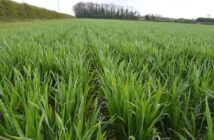Mutated UK net blotch isolates that are less sensitive to succinate dehydrogenase inhibitor (SDHI) fungicides have been detected at high enough frequencies to raise concerns about efficacy.
The discovery was made during tests on barley samples from a field that hosted an AHDB fungicide performance trial in 2016, in which straight SDHI products gave variable and poorer than expected performance against net blotch.
Although field control should not be significantly impacted in 2017, provided appropriate mixtures of actives are used, the findings provide further evidence of the need to follow guidance issued by the Fungicide Resistance Action Group UK (FRAG–UK).
Fungicide performance trials
The effectiveness of fungicides against net blotch in winter barley is tested as part of independent AHDB fungicide performance trials.
At the 2016 AHDB Agronomists’ Conference, Stuart Knight of NIAB reported that straight SDHI performance was ‘disappointing’ in one 2016 trial that tested a range of products against net blotch in a protectant situation.
As good performance was observed from the straight azole (Proline) and mixtures in the same Norfolk-based trial, it pointed to a possible SDHI efficacy effect, rather than a seasonal effect.
Paul Gosling, who manages fungicide performance and resistance work at AHDB, said: “When compared to the previous three years, 2013 to 2015, the drop in straight SDHI performance in 2016 was quite pronounced.
“The two solo SDHIs trialled failed to achieve more than 30 to 40 per cent control of net blotch, even at the full label rate.
“We wanted to investigate possible reasons for the observed poor performance, so we analysed samples though our complementary screening work to quantify any changes in pathogen sensitivity and identify if DNA mutations, which cause fungicide target protein changes, were present.”
Mutation screening
Leaf samples were taken from winter barley volunteers at the affected trial site by NIAB.
From these samples, twelve net blotch isolates were isolated and tested for fungicide sensitivity. Additional genotyping showed that nine of these isolates contained mutations in the SDHI binding site formed by succinate dehydrogenase (Sdh) subunits B, C and D. Three types of Sdh mutations were detected: D-H134R (five isolates), C-S135R (three isolates) and C-H134R (one isolate). A clear genotype-to-phenotype relationship was also established, meaning that the mutant isolates were less sensitive to SDHIs.
Bart Fraaije, who conducted the screening studies at Rothamsted Research, said: “These mutations have been found in Europe but it is the first time they have been found at high frequencies in a UK population and it helps explain the poor performance observed in the 2016 trial.
“We will continue to monitor the situation to help establish the spread and frequency of Sdh mutations in UK net blotch populations.”
Resistance guidance
Fiona Burnett, SRUC and chair of FRAG-UK, said: “We now have evidence that several cereal pathogens have evolved mutations in the SDHI binding site of succinate dehydrogenase.
“Although frequency of these mutations has, so far, been low, it provides compelling evidence of the need for united action.
“The industry and science experts have come together as FRAG-UK and agreed anti-resistance guidelines for fungicides that are practical and easy to implement.
“The guiding principle is to make life as hard as possible for pathogens by avoiding overexposure to any one fungicide group. Certainly, SDHIs should always be used in balanced mixtures, never applied with weak partners or outside of statutory limitations. The addition of multisites to programmes also adds protection.
“It is more important than ever to follow FRAG-UK guidance, as it is the most effective way to slow the emergence of these mutations and maintain the disease control that growers need.”
The 2016 fungicide performance presentation and FRAG guidance can be found at cereals.ahdb.org.uk/fungicide




